The signing of the joint vision statement by the UK Secretary of State for Defence Sir Michael Fallon and the Dutch Minister of Defence Jeanine Hennis-Plasschaert in June 2017 marked a formal step forward to strengthen the bilateral defence cooperation between the UK and the Netherlands. But what has been the impact of Brexit on this relationship in terms of Defence and Security? To understand the strengths and vulnerabilities of UK-NL bilateral defence cooperation at the strategic, operational and tactical levels, the five most relevant of twelve characteristics developed by Zandee et al. for defence cooperation, and Valasek’s research on EU military collaboration can be applied. It is clear that Brexit led to new opportunities, but the relationship is also facing serious challenges.
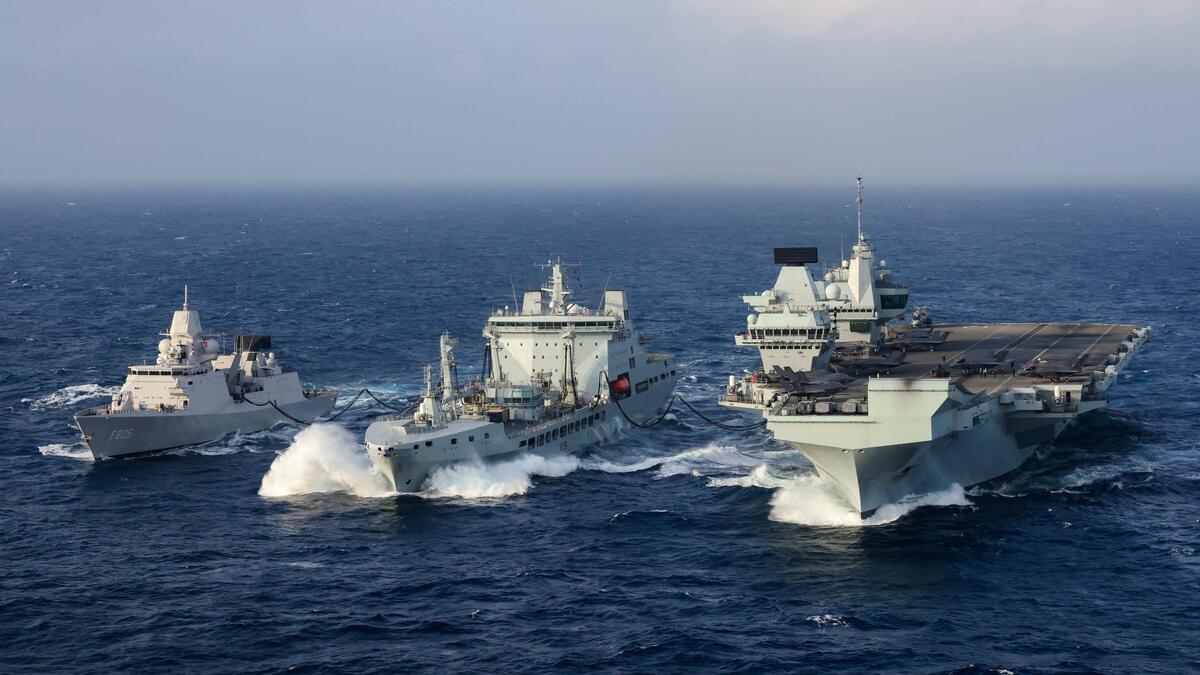
Zr.Ms Evertsen takes part in the UK Carrier Strike Group 2021. Photo UK Ministry of Defence
During his State Visit in 2018, amid Brexit uncertainty, His Majesty King Willem-Alexander addressed the House of Commons in the following words: ‘Our ties will never be broken. However high the waves may rise, the United Kingdom will always remain an important partner’.[1] While the United Kingdom’s (UK) departure from the European Union (EU) has had a significant impact on international relations in Europe, the bilateral defence relationship between the UK and the Netherlands has seemingly continued to flourish. This paper aims to identify the impact of Brexit on the bilateral relationship between the UK and the Netherlands in terms of defence and security in order to better understand why this close relationship endures.
Before identifying the specific strengths and weaknesses of the bilateral relationship between the UK and the Netherlands, a brief outline of the theoretical rationale of defence and security cooperation between nations will be given. For this purpose a conceptual framework of small state behaviour and asymmetric relationships, focusing specifically on military cooperation between the armed forces as a key aspect of foreign policy, will be used. Drawing on public information and current British, Dutch and EU policy documents, this paper will then address British and Dutch defence cooperation policy and its impact upon their bilateral relationship. Finally, it will discuss the opportunities and risks to future defence cooperation resulting from Brexit and then conclude that Brexit has initially increased the UK’s appreciation of its long-standing bilateral defence relationships with the Netherlands and other allies, creating new opportunities for cooperation. However, since the UK’s departure from the EU remains in practice embryonic, and with the UK and the EU rebalancing their defence and security priorities, uncertainty in bilateral affiliation will remain for the foreseeable future.
Understanding the UK-Netherlands bilateral relationship
The social theory of international politics describes the behaviour of states in international politics while promoting their national values and interests. Alexander Wendt identifies four interests for a state to survive: physical survival, autonomy, economic well-being, and collective self-esteem. One of the strategies to address these interests is through multilateral and bilateral cooperation.[2] For instance, after the Second World War the Netherlands drastically altered its security policy from neutrality to positively integrating itself fully in the international community. As one of the founders of the North Atlantic Treaty Organisation (NATO) and the EU, it secured both its physical security and economic interests at the cost of reduced autonomy.[3] Alternatively, the UK as a former world player and, arguably, today still formidable power, seems to have some more leeway to prioritise autonomy and self-esteem. Among other motives, such as immigration and living conditions, this seemingly contributed to the slender majority vote to leave the EU.[4]
In their defence and security policies both the UK and the Netherlands seek international cooperation to promote their national security objectives and recognise the importance of their bilateral relationship. The UK’s approach to defence engagement, published in 2017, aims to (1) develop understanding, (2) prevent conflict, (3) build capability and capacity, (4) promote prosperity and (5) gain access and influence.[5] Based on these principles and underpinned by the recently published 2021 Defence Command Paper (DCP) – Defence in a competitive age - the UK armed forces collaborate extensively with many partners worldwide, both multilaterally and bilaterally.[6] The UK still appreciates the Netherlands as a close ally with whom it has shared views on security threats and extensive bilateral defence initiatives and engagements.[7]
In its 2018 Defence White Paper, the Dutch government recognised the need for increased international defence and security collaboration, especially with the EU, NATO and its six strategic partners, the United States (US), the UK, Germany, France, Belgium, and Norway.[8] The aim was: (1) to support political-strategic objectives, (2) enhance military capabilities, and (3) achieve military efficiency.[9] Cooperation with the UK may serve all these objectives. The Netherlands values its close links with the UK because of its position at the world stage, including its membership of the UN Security Council, the G7 and G20, strong ties with the US, mature intelligence infrastructure, and credible armed forces.
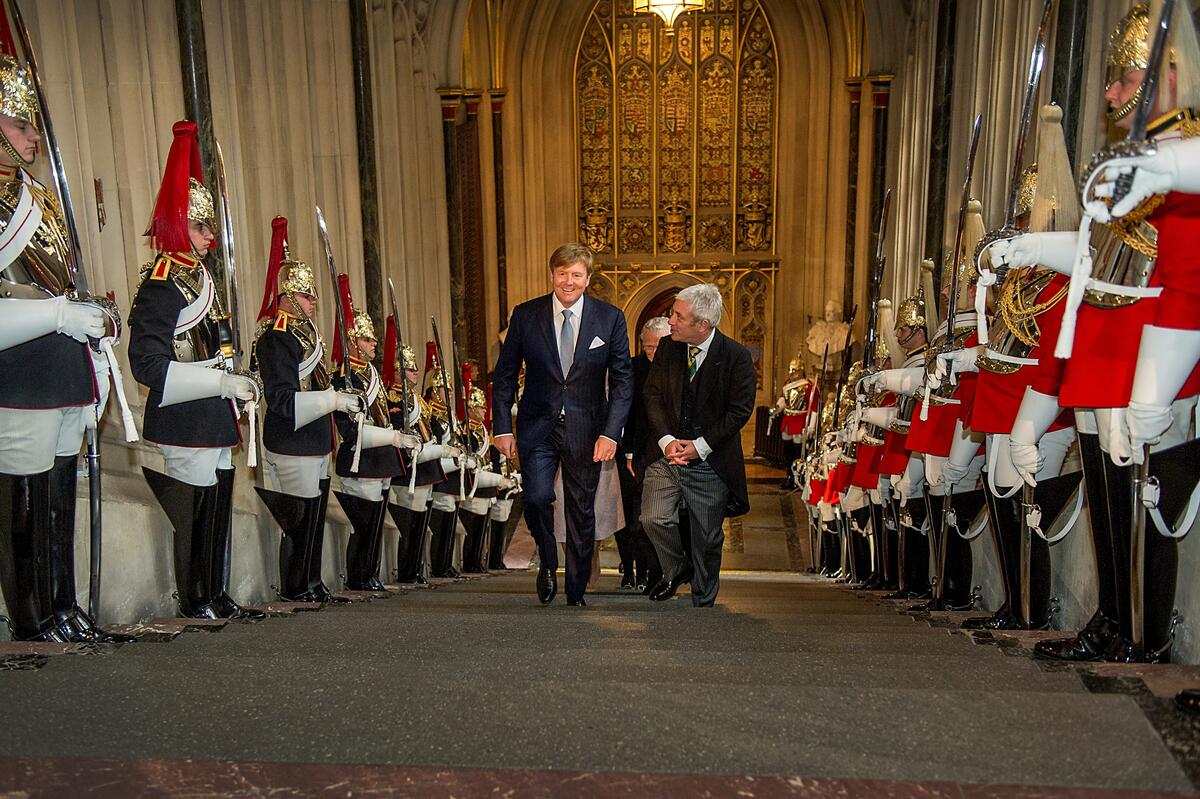
King Willem-Alexander and Queen Máxima arrive at the Houses of Parliament during their State Visit in 2018. Photo UK Parliament
The Dutch approach to its defence and security cooperation is motivated by its relative size within Europe, where the Netherlands may be regarded as ‘the biggest of the small, or the smallest of the big powers’.[10] Consequently, the ‘small state strategy’ of ‘harnessing the multilateral order’, as described by Hillary Briffa, sufficiently explains the behaviour of the Netherlands.[11] This approach to offset the structural limitations of its capabilities by pooling together with others to benefit from collective security, perfectly encapsulates the Dutch practice of joining several multilateral security constructs, such as the UK-led Joint Expeditionary Force (JEF)[12] and the French-led European Intervention Initiative, and establishing strategic defence partnerships with several close and significant allies.
The UK and the Netherlands not only acknowledge the general importance of international collaboration, but they also specifically mention each other in their strategic documents, albeit not exclusively. The Netherlands refers to the UK as one of its six strategic partners, whilst the UK commends the Netherlands for being its partner in the JEF and one of the four partners (together with the US, France and Norway) with which it focuses on deep inter-operability.[13] A 2021 House of Lords report on UK Bilateral Defence Cooperation acknowledges the UK-NL bilateral relationship as one of the UK’s three primary bilateral defence cooperation relationships with EU-countries (together with France and Germany).[14] Hence, both the UK and the Netherlands specifically appreciate their bilateral partnership in a broader international defence framework.
Strengths and vulnerabilities in the bilateral relationship
Defence cooperation may be established at three different levels of a military operation.[15] First, at the strategic level, collaboration includes strategic dialogue, joining and supporting multilateral defence and security structures, and structured cooperation, with a significant impact on a nation’s autonomy. Second, operational level cooperation covers collaboration at the level of single or multiple (joint) services, participation in operational staffs, operational support and deployments, and aligning major investment programmes. Finally, military cooperation on the tactical level constitutes improving interoperability through combined operations, training and exercises, personnel exchange programmes, and sharing information.[16]
To understand the strengths and vulnerabilities of UK-NL bilateral defence cooperation at these levels, the five most relevant of twelve characteristics developed by Dick Zandee et al. for defence cooperation, and Tomas Valasek’s research on EU military collaboration, will be applied to this case study.[17]
Firstly, Zandee et al. consider geographic proximity and shared history a significant enabler of cooperation. Being ‘North Sea neighbours’, the UK and the Netherlands share a maritime focus and a vital interest in safe, secure and responsible exploitation of the North Sea. Both are significant stakeholders.[18] Similarly, shared historical experiences add to like-mindedness and a fruitful bilateral relationship. The historical ties between the UK and the Netherlands date back at least four centuries. The two countries are constitutional monarchies with shared bonds and are former colonial powers. Both, traditionally, have a global view, embrace liberal democratic values, and promote the international rules-based order. Several decades of maritime rivalry and war in the 17th century were followed by centuries of close cooperation and a strong friendship. During WWII, the British government offered a safe home to the Dutch Royal family, the Dutch government in exile in London and the Dutch armed forces, who joined the Allied forces in the liberation of Western Europe.[19] As recently as June 2017, the British and the Dutch jointly and amicably commemorated the 350th anniversary of the Raid on Chatham by Admiral the Ruyter in 1667, also known as the Battle of Medway, under the banner ‘From fire to friendship’ in the presence of their Royalties. Moreover, British units of the Parachute Regiment still contribute yearly to the commemoration of Operation Market Garden near Arnhem. These notable examples indicate the close relationship nurtured by the two countries.
Secondly, Zandee et al. and Valasek argue that a resemblance of strategic cultures stimulates collaboration, especially when deploying the military in operations abroad in the high-end spectrum.[20] A comparison of the strategic cultures of the UK and the Netherlands reveals many similarities but also some significant differences. Both countries favour the same foreign policy orientation, considering NATO as the foundation of collective security in the Euro-Atlantic area. Furthermore, they feel a shared sense of responsibility towards global security, giving precedence to multilateralism and favouring international cooperation.[21] The alignment of strategic culture plausibly enabled the Netherlands to join the UK, the US, and Canada in taking the lead in Regional Command South (RC-South) in Afghanistan in 2006.
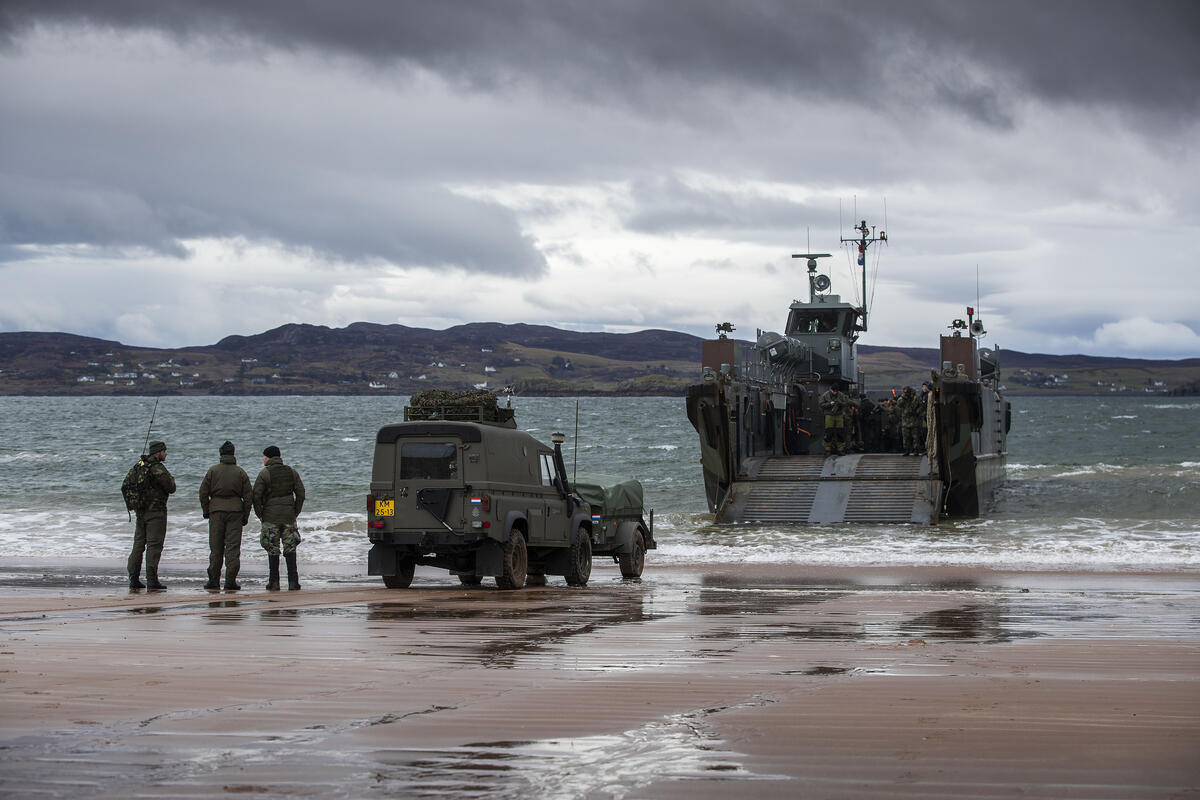
Dutch amphibious forces exercise in Scotland during Joint Warrior (2019). Photo MCD, Jasper Verolme
On the other hand, differences in strategic cultures present potential vulnerabilities in the relationship between the partners. The nature of the political system in the Netherlands and the persistent hesitation among some political parties to deploy military power regularly result in a reluctance to commit to international missions. These domestic politics contributed to the decision of the Netherlands to stop its commitment to RC-South in 2010 which is arguably why the UK/NL-Amphibious Force has not been deployed more often.[22],[23] Generally, the UK could be considered the more forward-leaning partner of the two, with a military doctrine emphasising a warrior ethos.[24] The Dutch less ambitious defence budget also represents the reluctant military culture of the Netherlands. While these dissimilarities in strategic culture effectuate limitations in deploying forces jointly, other bilateral defence cooperation elements, such as training and education, remain viable.
Thirdly, Zandee et al. recognise joint planning and standardisation of equipment, doctrines, and equipment as vital enablers of defence cooperation at the operational and tactical level.[25] Especially, the British Royal Navy (RN) and its counterpart, the Royal Netherlands Navy (RNLN), have established a long tradition of aligning exercise and training programmes. For instance, the RNLN is a standing partner of the RN’s Operational Sea Training (OST) organisation for training crews aboard warships, resulting in commonality in maritime doctrines and procedures. Furthermore, both countries coordinate the equipment programmes of their Marines to ensure interoperability within the UK/NL-Amphibious Force.
A fourth characteristic is the size of the partners. Zandee et al. and Valasek both conclude that cooperation between partners of comparable size will work better than between partners of different size. In its bilateral relationship with the UK, the Netherlands is the minor and secondary partner; in 2020, its GDP was 34 per cent relative to the $3,019 trillion of the UK, its population of 17.2 million is considerably smaller than the 66.4 million in the UK, and its defence spending of $13,1 billion in 2020 is only approximately a fifth of the UK’s $61.9 billion.[26] Because of these differences, the bilateral relationship between the UK and the Netherlands is subject to the dynamics of an asymmetric relationship.
Stéfanie von Hlatky captures these asymmetries in her theory of asymmetric security cooperation. She explains the trade-offs that partners might face, especially a potential loss of autonomy in foreign policy decision-making. Challenges could arise if the dominant ally wishes to intervene in response to an international threat, which its secondary allies may not share. Alliance considerations may become a compelling motive.[27] For example, in 2003, the Dutch government found itself in a difficult position when asked by its UK and US allies to support the disputed invasion of Iraq, and did so only politically. However, Hlatky clarifies that minor powers may smartly exploit essential resources for security interdependence, such as geography, capability specialisation and legitimacy. For instance, the Dutch could enhance defence cooperation by leveraging its military presence in the Caribbean and its world-class cyber capabilities.[28]
Finally, Zandee et al. and Valasek argue that defence cooperation’s most crucial success factor is trust, confidence and understanding, primarily when operating together. Trust can grow over time and help overcome vulnerabilities related to differences in size.[29] The British and the Dutch armed forces have established activities to build trust and confidence through joint training and exercises (e.g., the yearly Dutch participation in the UK’s Joint Warrior exercises), exchange of military personnel between all services, joining each other’s staff-colleges, and frequent staff-talks and bilateral meetings. Consequently, despite their differences in size and strategic culture, the British and Dutch armed forces have a lot in common, which has resulted in a solid base for robust close cooperation in defence and security.
As a result, until 2017 the UK-NL defence cooperation mainly evolved at the operational and tactical level and concentrated on long-standing navy-to-navy relations. This includes over 60 years of participation in the Operational Sea Training (OST); almost 50 years of cooperation between the Royal Marines and the Royal Netherlands Marine Corps in the integrated UK/NL-Amphibious Force, collaboration in the Submarine Command Courses, and decades of exchange programmes at staff and tactical levels and in the field of operational education. Consequently, this has enabled a high level of standardisation and interoperability, exchange of personnel and knowledge, and efficient bilateral use of scarce capital resources, such as amphibious ships and helicopters.[30]
Cooperation between respective armies and air forces has also grown; however, not to the extent of the Atlantic-orientated naval and marine cooperation. The Netherlands Army, whose focus is more continental, primarily cooperates with Germany. Because of its equipment, the Royal Netherlands Air Force predominantly cooperates with the US. Nevertheless, the British and Dutch armies and air forces share doctrines and information, exchange personnel, and regularly conduct combined training.
Opportunities and challenges following Brexit
Where operational and tactical cooperation has continuously evolved, political developments have also had strategic implications. The decision of the British government to leave the EU in 2016 has impacted British foreign and defence policy and the political dynamics in this field in Europe. The EU lost a partner with considerable ‘hard power’ capabilities. The UK separated from the EU, a notable ‘soft power’ actor, focusing on crisis prevention, crisis management, and post-conflict stabilisation. During Brexit negotiations the subjects of defence and security were hardly mentioned, so ‘the formal cooperation with the UK on defence matters will now be subject to strict rules on third-country participation’, constraining the UK-EU defence and security cooperation significantly.[31] Consequently, for its European defence and security cooperation the UK now principally depends on NATO, the Joint Expeditionary Force (JEF), its trilateral relationship with France and Germany, and other bilateral initiatives.
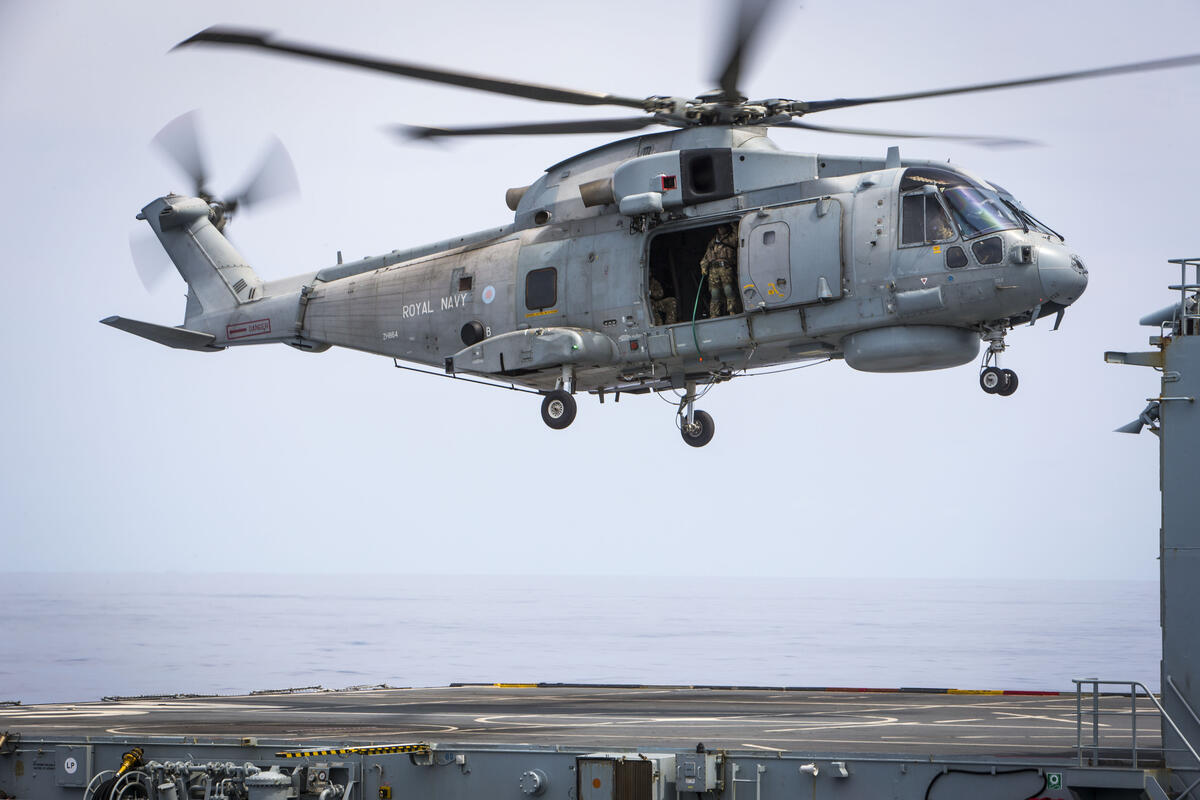
A Royal Navy helicopter delivers goods to the Dutch Joint Support Ship Zr.Ms. Karel Doorman. Photo MCD, Eva Klijn
As such, it was anticipated that the UK would emphasise the importance of NATO, the JEF, its bilateral relationships, and smaller multilateral formats to limit the negative impact of Brexit on European defence.[32] It followed then that bilateral cooperation with the Netherlands and others received new attention and created new opportunities. The signing of the joint vision statement by the UK Secretary of State for Defence Sir Michael Fallon and the Dutch Minister of Defence Jeanine Hennis-Plasschaert in June 2017 marked a formal step forward to strengthen the bilateral defence cooperation between the UK and NL.[33] It enhanced collaboration at the strategic level by introducing a formal structure for dialogue and an action plan to direct the deepening and widening of the partnership towards new areas such as cybersecurity and space.[34]
It was not until March 2021 that the British government published a clear post-Brexit vision: the UK’s Integrated Review of Security, Defence, Development and Foreign Policy (IR). It outlines the UK’s interests concerning sovereignty, security, and prosperity.[35] The IR heralds a step-by-step change in how the UK envisions engaging and operating across the world and stresses the importance of relationships with allies and partners. Following the IR, the DCP sets out what this means for UK’s defence.[36] It acknowledges today’s threats, the existence of global competition over trade, values and interests and the ways in which new technologies may potentially do damage without fighting in the open. Both papers reiterate the UK’s increased global interests while remaining unequivocally committed to European security through NATO, the JEF and strong bilateral relations.[37]
The UK’s analysis of the future security environment, as presented in the DCP, predominantly corresponds to the Dutch Defence Vision 2035 (DV2035).[38] The UK as well as the Netherlands underline the importance of flexibility of action, multi-domain integration, operations below the threshold of war with technology at the heart of the new approach, and international cooperation as a prerequisite. Furthermore, due to the limited size of the Dutch armed forces, there is an increased focus on quality, both in equipment and training, rather than on quantity.
From these similar assessments new opportunities and areas of cooperation on the strategic, operational and tactical level may arise. For example, the two armed forces can join efforts to develop new doctrines and capabilities to operate on the ‘future battlefield’. The Netherlands, being the less powerful partner, may continue to smartly exploit its strengths, such as its EU membership, position in the Caribbean, cyber capabilities, and availability of scarce high-end military capabilities, such as air defence frigates and amphibious ships. In this way, the UK and the Netherlands can capitalise on the strong foundations of their bilateral relationship by creating new opportunities to offset some of the disadvantages of the UK's departure from the EU.
In the maritime domain an already solid naval cooperative relationship will be further enhanced with the current integration of a Dutch frigate, as the only foreign partner alongside the US, into the 2021 UK Carrier Strike Group’s operational maiden tour to the Indo-Pacific. The cooperation during this significant deployment underlines the continuation of the close ties between the UK and the Netherlands in the post-Brexit era. Additionally, the need to advance NATO’s amphibious capabilities presents an opportunity for increased cooperation in this critical area.[39] Consequently, the two nations are developing a mutual Maritime Roadmap to further enhance structural bilateral maritime collaboration into the next decade.
In the land domain similar opportunities present themselves. The British Army has published its plans as ‘Future Soldier – Transforming the British Army’, including introducing the Brigade Combat Teams (BCT), a newly-established Army Special Operations Brigade and the introduction of future technologies to modernise and transform its forces.[40] The Army’s investment programmes have significant overlap with the Royal Netherlands Army (RNLA) vision of being a robust, agile and reliable partner.[41] Specifically, the further development of the Army’s Information Manoeuvre and Unconventional Warfare forces[42], and the choice of the British Army to buy the Boxer multirole armoured fighting vehicle, which is already in use by the Dutch and German Armies, are potentially excellent opportunities for strengthening further bilateral cooperation at the operational and tactical level.
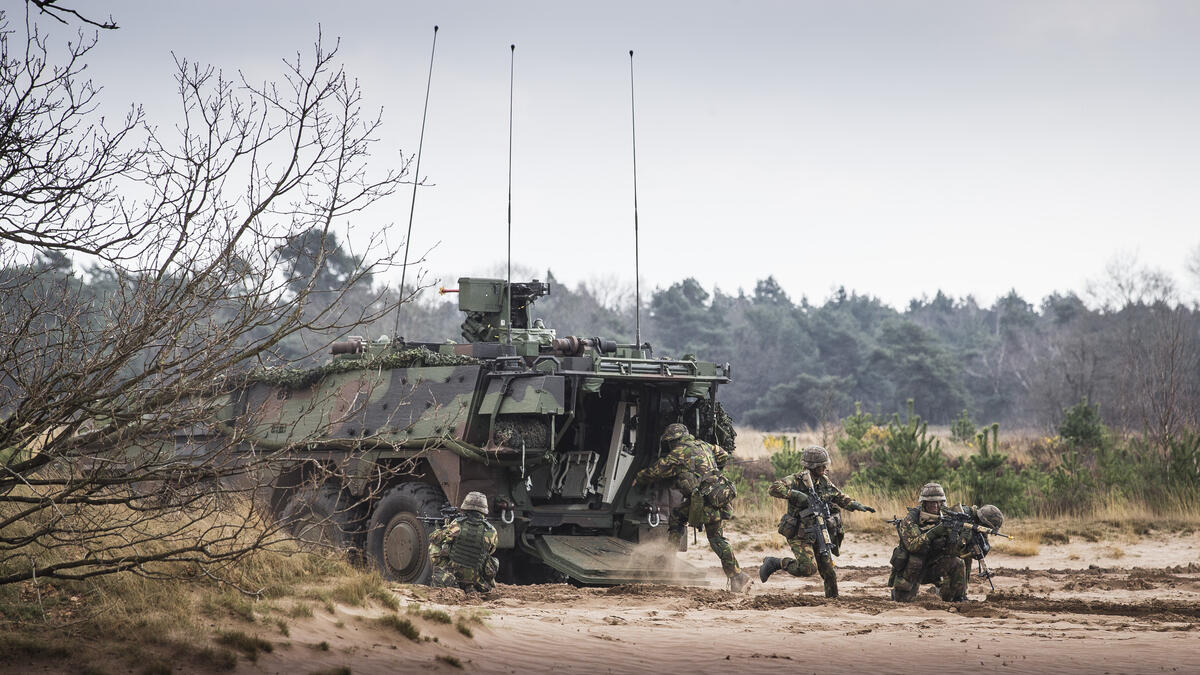
Dutch infantry exercise with the Boxer armoured vehicle. The British Army also acquires Boxers, creating opportunities for strengthening further bilateral cooperation at the operational and tactical level. Photo MCD, Joyce Rutjes
In the air domain the two countries deploy a growing set of similar airframes; F35, Apache, Chinook, MQ9 Reaper, C130, and C17 Globemaster. With a decrease of the strategic air fleet the Dutch-led international A330 MRTT programme could be the impetus for more collaborative programmes. Moreover, the Royal Air Force will make a £2bn strategic investment in the Future Combat Air System (FCAS). The development of this technologically innovative mix of crewed and un-crewed platforms, combined with the current fleet of airframes, provides a fertile basis for further cooperation in training, research, and development.
Finally, with an investment of at least £6.6bn in research and development over the next four years, UK Armed Forces seek to sustain their strategic advantage through science and technology, especially in the cyber and space domain, and full integration across all domains (MDI).[43] The MOD significantly contributes to the joint establishment of the UK National Cyber Force and establishes a new Space command to enhance the UK’s military command and control in space.[44] The Dutch Defence Cyber Command and its single services might want to closely monitor these developments and adoptions in new technologies and try to find cooperation in the collective ability to operate as partners in these new domains.
Despite these opportunities, the bilateral relationship between the UK and the Netherlands is also facing the serious challenges of the years ahead. While Brexit signified a blow to European security cooperation, it also spurred renewed interest in developing a more integrated approach to European security, mainly along the French-German axis.[45] New EU initiatives on Common Security and Defence Policy, such as Permanent Enhanced Cooperation, the European Defence Fund and operational EU-deployments, could compete with increased bilateral UK cooperation. For instance, in 2019 the Netherlands did not choose to join the US-UK-led International Maritime Security Construct for maritime stability and security around the Arabian Peninsula, but instead joined the European Maritime Awareness mission, a mission with a similar objective. Moreover, although the EU and UK favour the democratic liberal order, differences may arise in their strategic approaches towards Russia, China, or Iran concerning foreign policy challenges. In case of conflicting interests and scarcity of resources, the Netherlands is likely to follow the EU approach in its foreign and defence policy, which may strain the bilateral relationship.[46]
Other risks relate to the limited resources relative to both British and Dutch ambitions. James identified the ‘overstretched Armed and Diplomatic Services’ as one of the UK’s grand strategic thinking weaknesses, creating challenges to deliver on its high ambitions, including refocusing on new partners and the Indo-Pacific.[47] Likewise, in its DV2035 the Netherlands similarly declared insufficient financial and personnel resources as one of the most pressing issues to be solved.[48] Therefore, the two partners must balance their defence commitments multilaterally and bilaterally. Consequently, shortage of capabilities, money and workforce is a risk, potentially leading to a lack of focus and the inability to deliver on the bilateral opportunities and ambitions, conceivably endangering the relationship.
Finally, the UK as well as the Netherlands should realise that the process of the UK forming a new relationship with the EU is not finished yet. Still, many uncertainties about the future partnership remain, with the risk of a further increase of tensions, for instance, over fisheries, handling the COVID-19 crisis, or Northern Ireland. In 2019 Dutch Prime Minister Mark Rutte reiterated the Dutch commitment to more and closer EU cooperation, ‘because if the chaos of Brexit teaches us anything, it’s that there's no such thing as splendid isolation’.[49] Therefore, a deteriorating connection between the UK and the EU could become harmful to British-Dutch bilateral relations.
To conclude, this paper sought to identify the impact of Brexit on the bilateral defence relationship between the UK and the Netherlands. Before Brexit, over a long period of time the two countries developed strong bonds between their defence forces, mainly supported by a shared history, close geographic proximity, and a high level of interoperability. Vulnerabilities because of differences in size and strategic culture are compensated through frequent dialogue and trustful collaboration.
While the decision of the UK to leave the EU potentially had a detrimental impact on the bilateral relationship, it has not directly affected defence and security yet. Instead, either country took the opportunity to expand its bilateral defence cooperation in word and deed. During the aforementioned 2018 State Visit, Her Majesty the Queen stated, ‘As we continue to work together to ensure peace, prosperity and security, I am confident that this friendship between The United Kingdom and The Netherlands, which we greatly treasure, will continue to deepen, and to prosper’.[50]
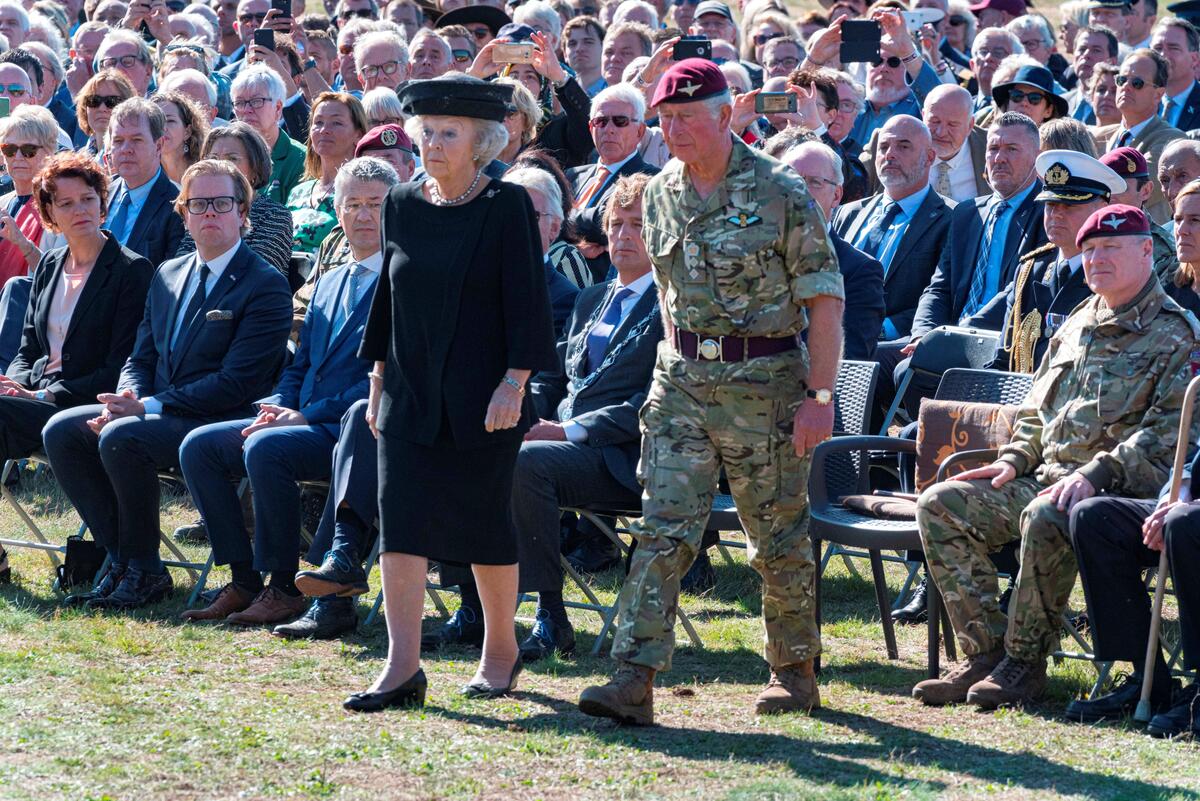
Princess Beatrix and Prince Charles attend the 2019 commemoration ceremony of Operation Market Garden in Ede. Photo MCD, Louis Meulstee
However, Brexit is still fresh, and many uncertainties remain, especially if the foreign and security policies of the UK and EU deviate. It is also questionable if the UK and the Netherlands can deliver on the bilateral opportunities, especially because of scarce resources, high ambitions and different international priorities. Building confidence and trust through continuous dialogue and new initiatives will therefore remain essential to continuing a strong and mutually beneficial bilateral relationship. However, dialogue alone will not be enough. To remain trustworthy partners, intentions need to be followed up by action.
[1] ‘Speech by His Majesty the King on the occasion of his visit to the House of Commons and the House of Lords’, London, 23 October 2018. See: https://www.royal-house.nl/documents/speeches/2018/10/23/speech-by-his-majesty-the-king-on-the-occasion-of-his-visit-to-the-house-of-commons-and-the-house-of-lords-palace-of-westminster.
[2] Alexander Wendt, Social Theory of International Politics (Cambridge, Cambridge University Press, 1999) 235.
[3] Nick Perre, ‘Dutch Strategic Culture-A Case Study’, (MA Thesis, Leiden University, 2018) 21-22.
[4] Christopher Browning, ‘Brexit Populism and Fantasies of Fulfilment’, in: Cambridge Review of International Affairs 32 (2019) (3) 222–244. See: https://doi.org/10.1080/09557571.2019.1567461.
[5] UK Ministry of Defence (MoD), UK’s International Defence Engagement Strategy, 2017, 20.
[6] UK MoD, Defence in a Competitive Age, 2021.
[7] Linda Dann, ‘The Future of the Arnhem Spirit’, in: Paul Dimond, Jane Fenoulhet and Elisabeth Salverda (eds.), North Sea Neighbours-British and Dutch Interaction Over 100 Years (London, Anglo-Netherlands Society, 2020) 155–56.
[8] NL MoD, 2018 Defence White Paper, 2018. See: https://english.defensie.nl/downloads/policy-notes/2018/03/26/defence-white-paper.
[9] NL MoD, ‘Kamerbrief 2 33 279 - Internationale Militaire Samenwerking’, 2015. See: https://zoek.officielebekendmakingen.nl/kst-33279-16.html.
[10] Jorg Noll and René Moelker, ‘Netherlands’, in: Alexandra Biehl, Heiko Biehl, Bastian Giegerich (eds.), Strategic Cultures in Europe: Security and Defence Policies Across the Continent (Wiesbaden, Springer Fachmedien Wiesbaden, 2013) 257. See: https://doi.org/10.1007/978-3-658-01168-0.
[11] Hillary Briffa, ‘Small States and the Challenges of the International Order’, in: Seth Center and Emma Bates (eds.), After Disruption-Historical Perspectives on the Future of International Order, CSIS, 2020, 50–59. See: https://csis-website-prod.s3.amazonaws.com/s3fs-public/publication/200901_Bates_History_FullReport_v1.pdf.
[12] The Joint Expeditionary Force (JEF) is a pool of high-readiness forces from nine countries – Denmark, Estonia, Finland, Latvia, Lithuania, the Netherlands, Norway and Sweden and the UK, which leads it. These countries share a commitment to democracy, individual liberty and the rule of law as well as a long history of operating together.
[13] UK MoD, ‘Defence in a Competitive Age’, 19.
[14] Claire Brader, ‘UK Bilateral Defence Cooperation’, London, 2021. See: https://lordslibrary.parliament.uk/uk-bilateral-defence-cooperation/.
[15] Daniel Sukman, ‘The Institutional Level of War’, Real Clear Defense, 2016. See: https://www.realcleardefense.com/articles/2016/05/06/the_institutional_level_of_war_109338.html.
[16] Brandon Kinne, ‘Defense Cooperation Agreements and the Emergence of a Global Security Network’, in: International Organization 72 (2018) (4) 803. See: https://doi.org/10.1017/S0020818318000218.
[17] Dick Zandee, Margriet Drent and Rob Hendriks, ‘Defence Cooperation Models: Lessons Learned and Usability’, (The Hague, Clingendael, 2016) 4-6; Tomas Valasek, ‘Surviving Austerity-The Case for a New Approach to EU military cooperation’, (London, CER, 2011) 17-23. See: https://www.cer.org.uk/sites/default/files/publications/attachments/pdf/2011/rp_981-141.pdf.
[18] House of Lords-European Union Committee, ‘The North-Sea Under Pressure: Is Regional Marine Co-Operation the Answer HL 137’, 10 March, 2015, 78. See: http://www.publications.parliament.uk/pa/ld201415/ldselect/ldeucom/137/13702.htm.
[19] The first Dutch Special Forces (KCT) were formed in 1942 in Scotland as No. 2 Dutch Troop. See:
Arthur ten Cate and Martijn van der Vorm, Callsign Nassau. Het moderne Korps Commandotroepen 1989-2012 (Amsterdam, Boom Uitgeverij, 2012) 12.
[20] Zandee et al., ‘Defence Cooperation Models’, 4-5. Valasek, ‘Surviving Austerity’, 21-22.
[21] Paul Cornish, ‘United Kingdom’, in: Strategic Cultures in Europe, 371–84.
[22] In 2010, after four years of intense allied cooperation, the Dutch coalition government was not able to politically agree on the continuation of Dutch military support to NATO-operations in RC-South.
[23] Valasek, ‘Surviving Austerity’, 17-23.
[24] Margriet Drent, Wouter Hagemeijer and Kees Homan, ‘Internationale Militaire Samenwerking: Knelpunten en Kansen’, Clingendael Policy Brief, no. 6 (2011) 6.
[25] Zandee, ‘Defence Cooperation Models’, 6.
[26] Population and GDP (in $) according to the OECD. See: https://data.oecd.org/pop/population.htm and https://data.oecd.org/gdp/gross-domestic-product-gdp.htm#indicator-chart. Defence spending (in $) according to NATO, ‘Defence Expenditure of NATO Countries (2014-2021) PR/CP(2021)094, 11 June 2021, 7. See: https://www.nato.int/nato_static_fl2014/assets/pdf/2021/6/pdf/210611-pr-2021-094-en.pdf.
[27] Stéfanie von Hlatky, ‘Theory of Asymmetric Security Cooperation’, in: American Allies in Times of War: The Great Asymmetry, 15:583–605. (Oxford: Oxford Scholarship, 2013).
[28] ‘Digital Dominance-A New Global Ranking of Cyber-Power Throws up Some Surprises’, in: The Economist, 19 September, 2020. See: https://www.economist.com/science-and-technology/2020/09/19/a-new-global-ranking-of-cyber-power-throws-up-some-surprises.
[29] Zandee, ‘Defence Cooperation Models’, 4-5.
[30] Royal Navy, ‘Anglo-Dutch task groups link up in Mediterranean’, 25 September, 2020. See: https://www.royalnavy.mod.uk/news-and-latest-activity/news/2020/september/25/20200925-anglo-dutch-task-groups-link-up-in-mediterranean.
[31] Claire Mills and Ben Smith, ‘End of Brexit Transition: Implications for Defence and Foreign Policy Cooperation’, House of Commons Library Briefing Paper, no. 9117, 19 January, 2021. See: https://commonslibrary.parliament.uk/research-briefings/cbp-9117/.
[32] Ana-Isabel Xavier, ‘The impact of Brexit on security and defence multilateralism: more cooperation or overlapping interests?’, in: Marmara Journal of European Studies 26 (2018) (1) 101–118. See: https://avrupa.marmara.edu.tr/dosya/avrupa/mjes arsiv/vol 26_1/6_Xavier.pdf.
[33] UK MoD, ‘Defence Secretary Agrees Stronger Partnership with Netherlands’, 17 June, 2017. See: https://www.gov.uk/government/news/defence-secretary-agrees-stronger-partnership-with-netherlands.
[34] Dann, ‘The Future of the Arnhem Spirit’, 155–58.
[35] UK Government, The Integrated Review 2021, 16 March, 2021. See: https://www.gov.uk/government/collections/the-integrated-review-2021.
[36] UK Government, Defence Command Paper – Defence in a competitive age, March, 2021. See: https://assets.publishing.service.gov.uk/government/uploads/system/uploads/attachment_data/file/974661/CP411_-Defence_Command_Plan.pdf.
[37] UK Government Global Britain in a Competitive Age, London, 2021; UK MoD, Defence in a competitive age, 28-29.
[38] NL MoD, Defence Vision 2035, 15 October, 2020. See: https://english.defensie.nl/downloads/publications/2020/10/15/defence-vision-2035.
[39] J.D. Williams, et al. Unlocking NATO’s Amphibious Potential: Lessons from the Past, Insights for the Future (Santa Monica, CA, Rand Corporation, 2020). See: https://www.rand.org/pubs/perspectives/PEA695-1.html.
[40] UK MoD, Future Soldier – Transforming the British Army, 22 March, 2021. See: https://www.army.mod.uk/media/11826/20210322-army-future_soldier-publication-final.pdf.
[41] RNLA Directorate of knowledge and innovation, ‘IMC Strategy 2021-2025: Interoperability as key’, Utrecht 2021, 12-13.
[42] 6th (United Kingdom) Division prepares and generates forces, such as 77th Brigade and 1 ISR Brigade, for both constant competition and war fighting, as well as routinely conducting operations below the threshold of armed conflict in the virtual and physical dimensions.
[43] Multi Domain Integration (MDI) is the posturing of military capabilities in concert with other instruments of national power, allies and partners; configured to sense, understand and orchestrate effects at the optimal tempo, across the operational domains and levels of warfare (JCN 1/20).
[44] The UK NCF is a joint mission of the MoD, the Government Communications Headquarters (GCHQ), and the Secret Intelligence Service (SIS).
[45] Øyvind Svendsen, ‘Brexit and the Future of EU-Defence: A Practice Approach to Differentiated Defence Integration’, in: Journal of European Integration 41 (2019) (8) 1003. See: https://doi.org/10.1080/07036337.2019.1622540.
[46] Benjamin Martill and Monika Sus, ‘Post-Brexit EU/UK-Security Cooperation: NATO, CSDP+, or “French Connection”?’, in: The British Journal of Politics and International Relations 20 (2018) (4) 846–63. See: https://doi.org/10.1177/1369148118796979.
[47] William James, ‘Between a Pandemic and a Hard-Brexit’, in: The RUSI Journal 165 (2021) (7). See: https://doi.org/10.1080/03071847.2021.1889232.
[48] Defence Vision 2035, 17.
[49] Lisa ten Brinke, ‘From Cautious Member to Bold Leader? The Netherlands and EU after Brexit’, London School of Economics, 11 April, 2019. See: https://blogs.lse.ac.uk/brexit/2019/04/11/from-cautious-member-to-bold-leader-the-netherlands-and-eu-after-brexit/.
[50] ‘Speech by HM the Queen at The Netherlands State Banquet’, 23 October, 2018. See: https://www.royal.uk/queens-speech-netherlands-state-banquet.